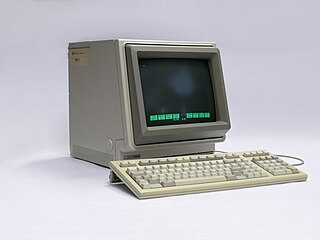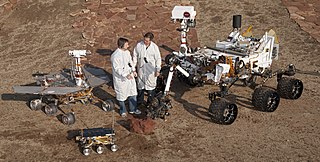An autonomous robot is a robot that acts without recourse to human control. Historic examples include space probes. Modern examples include self-driving vacuums and cars.

Suspended: A Cryogenic Nightmare is an interactive fiction video game written by Michael Berlyn and published by Infocom in 1983. Infocom's sixth game, it was released for Amstrad CPC, Apple II, Atari 8-bit computers, Commodore 64, Commodore Plus/4, IBM PC compatibles, TRS-80, and TI-99/4A. It was later available for Mac, Amiga, and Atari ST.

Nolan Kay Bushnell is an American businessman and electrical engineer. He established Atari, Inc. and the Chuck E. Cheese's Pizza Time Theatre chain. He has been inducted into the Video Game Hall of Fame and the Consumer Electronics Association Hall of Fame, received the BAFTA Fellowship and the Nations Restaurant News "Innovator of the Year" award, and was named one of Newsweek's "50 Men Who Changed America". He has started more than 20 companies and is one of the founding fathers of the video game industry. He is on the board of Anti-Aging Games. In 2012, he founded an educational software company called Brainrush, that is using video game technology in educational software.

Lego Mindstorms is a discontinued line of educational kits for building programmable robots based on Lego bricks. It was introduced on 1 September 1998 and discontinued on 31 December 2022.
Getty Images Holdings, Inc. is a visual media company and supplier of stock images, editorial photography, video, and music for business and consumers, with a library of over 477 million assets. It targets three markets—creative professionals, the media, and corporate.

ASIMO is a humanoid robot created by Honda in 2000. It is displayed in the Miraikan museum in Tokyo, Japan. On 8 July 2018, Honda posted the last update of ASIMO on their official page stating that it would be ceasing all development and production of ASIMO robots in order to focus on more practical applications using the technology developed through ASIMO's lifespan. It made its last active appearance in March 2022, over 20 years after its first, as Honda announced that they are retiring the robot to concentrate on remote-controlled, avatar-style, robotic technology.

Roomba is a term that refers to a series of autonomous robotic vacuum cleaners made by the company iRobot, and was first introduced in September 2002. Roombas have a set of sensors which help them navigate the floor area of a home. These sensors can detect the presence of obstacles and steep drops.

The Texas Instruments LPC Speech Chips are a series of speech synthesizer digital signal processor integrated circuits created by Texas Instruments beginning in 1978. They continued to be developed and marketed for many years, though the speech department moved around several times within TI until finally dissolving in late 2001. The rights to the speech-specific subset of the MSP line, the last remaining line of TI speech products as of 2001, were sold to Sensory, Inc. in October 2001.

HP-150 was a compact, powerful and innovative computer made by Hewlett-Packard in 1983. It was based on the Intel 8088 CPU and was one of the world's earliest commercialized touch screen computers. Like other "workalike" IBM PC clones of the time, despite running customized MS-DOS versions 2.01, 2.11 and 3.20, the machine was not IBM PC DOS compatible. Its 8088 CPU, rated at 8 MHz, was faster than the 4.77 MHz CPUs used by the IBM PC of that period. Using add-on cards, main memory could be increased from 256 KB to 640 KB. However, its mainboard did not have a slot for the optional Intel 8087 math coprocessor due to space constraints. An HP-150 with an optional hard disk was called HP Touchscreen MAX.

BIG TRAK / bigtrak is a programmable toy electric vehicle created by Milton Bradley in 1979, resembling a futuristic Sci-Fi tank / utility vehicle. The original Big Trak was a six-wheeled tank with a front-mounted blue "photon beam" headlamp, and a keypad on top. The toy could remember up to 16 commands, which it then executed in sequence. There also was an optional cargo trailer accessory, with the UK version being white to match its colour scheme; once hooked to the Bigtrak, this trailer could be programmed to dump its payload.
HERO is a series of several educational robots sold by Heathkit during the 1980s. The Heath Company began the HERO 1 project in October 1979, with the first release in 1982. Models include the HERO 1, HERO Jr., and HERO 2000. Heathkit supported the HERO robot line until 1995. The units were either sold as assembly kits or prebuilt by Heathkit for an additional fee. The 1980s models are considered collectors items, due to their rarity. For the most part, they cannot perform practical tasks, but are more geared toward entertainment and education above all.

iCub is a one meter tall open source robotics humanoid robot testbed for research into human cognition and artificial intelligence.
Robotics is the branch of technology that deals with the design, construction, operation, structural disposition, manufacture and application of robots. Robotics is related to the sciences of electronics, engineering, mechanics, and software. The word "robot" was introduced to the public by Czech writer Karel Čapek in his play R.U.R., published in 1920. The term "robotics" was coined by Isaac Asimov in his 1941 science fiction short-story "Liar!"
The Omnibot (オムニボット) is a toy robot originally manufactured by Tomy in the mid-1980s. The name then came to apply to the successful line of robots manufactured by the company. The initial Omnibot was announced with expectations of restoring popular interest in robots, at a time when it was becoming obvious that robots with advanced AI such as R2-D2 were still a long way away. A more advanced version of the Omnibot was called the Omnibot 2000 and did not have a plastic bubble over its head. With the success of the Omnibots, the Omnibot range quickly expanded. After the video game crash of 1983 and its debilitating effect on the nascent home electronics industry, the Omnibot faded away but it was revived in the early 2000s. The latest version of the Omnibot is the i-SOBOT.

Operating System/Virtual Storage 1, or OS/VS1, is a discontinued IBM mainframe computer operating system designed to be run on IBM System/370 hardware. It was the successor to the Multiprogramming with a Fixed number of Tasks (MFT) option of System/360's operating system OS/360. OS/VS1, in comparison to its predecessor, supported virtual memory. OS/VS1 was generally available during the 1970s and 1980s, and it is no longer supported by IBM.
Eric R. Fossum is an Emmy award-winning American engineer who co-developed some of the active pixel image sensor with intra-pixel charge transfer, with the help of other scientists from the NASA Jet Propulsion Laboratory. He is a professor at Thayer School of Engineering in Dartmouth College.

Robotics is the interdisciplinary study and practice of the design, construction, operation, and use of robots.
Sente Technologies was an arcade game company. Founded as Videa in 1982 by ex-Atari employees Roger Hector, Wendi Allen, and Ed Rotberg, the company was bought by Nolan Bushnell and made a division of his Pizza Time Theatre company in 1983. In 1984 the division was acquired by Bally Midway who continued to operate it until closing it down in 1988. The name Sente, like Atari, is another reference to Bushnell's favorite game, Go and means "having the initiative."

A domestic robot or homebot is a type of service robot, an autonomous robot that is primarily used for household chores, but may also be used for education, entertainment or therapy. While most domestic robots are simplistic, some are connected to Wi-Fi home networks or smart environments and are autonomous to a high degree. There were an estimated 16.3 million service robots in 2018.

Fred D'Ignazio is an American author, educator, and television commentator. He was born in Bryn Mawr, Pennsylvania and is considered to be one of the world's leading pioneers in multimedia-based education. From 1972 to 1976, he was an assistant editor for The Futurist magazine published by the World Future Society. In the 1980s and 1990s he was an associate editor and columnist for COMPUTE! and COMPUTE!'s Gazette and a technology commentator on ABC's Good Morning America. He is also the author of over 20 non-fiction books on science and technology, as well as a series of juvenile science fiction novels.













